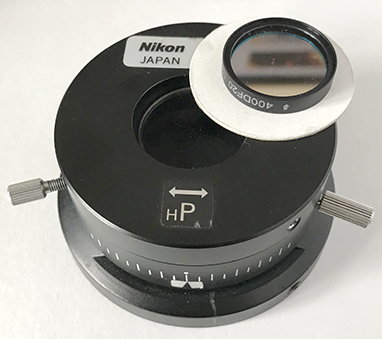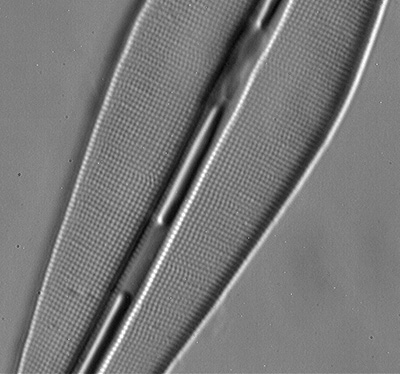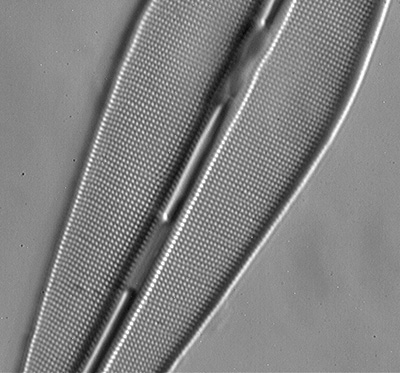|
Topical tip - using small diameter short wavelength interference filters on modern microscopes with a large field lens.
by David Walker,
UK
|
 A core concept of microscopy is that resolution is directly proportional to the wavelength of light used. By using deep blue or shorter wavelengths the resolution of well corrected objectives can be increased
where the NA is computed for green light. This is particularly popular for 'diatom dotting' (an 'affliction' which openly admit to having) and wishing to push optics to the limit to discern the finer details of a diatom frustule.
A core concept of microscopy is that resolution is directly proportional to the wavelength of light used. By using deep blue or shorter wavelengths the resolution of well corrected objectives can be increased
where the NA is computed for green light. This is particularly popular for 'diatom dotting' (an 'affliction' which openly admit to having) and wishing to push optics to the limit to discern the finer details of a diatom frustule.
Narrow band interference filters are preferred as the wavelength is decreased because the typical dyed glass filter can have a broad wavelength transmission. Interference filters are expensive and to be most cost effective it is worth determining the smallest diameter that can be used for the objectives of interest. Traditional stands such as the Zeiss Photomicroscope / Universal
often have a small field lens of ca. 22 mm diameter. A filter can be considerably smaller and only needs to be as large as the iris diameter when set for full field of the lowest mag objective likely to be used, e.g. the 40X. This has been discussed in an August 2008 Micscape article, where only a 10 mm diameter filter was required for objectives of 40X or higher mag (image right) Filters of this size are quite modestly priced at a few tens of pounds.
I am currently exploring the potential of a Nikon Eclipse 800 stand shared with my brother Ian, a more modern stand of the 90s which has a much wider field lens typically associated with a field iris further back in the optics train. The iris is set by a knob on the side (see last month's article where a problem with a seizing
field iris was corrected). The field lens is 40 mm diameter so it is worth exploring on this type of stand the minimum size of filter that is required. The approach is different to that of the Zeiss where the height above the field lens for the smallest circle of light needs to be determined (which for the Eclipse at least does not decrease in size as the field iris is stopped down.
A disc of tracing paper is useful for this as shown below with rule marks added if required. A card collar support could then be crafted to support a filter at this height. In my own setup, the Nikon de Sénarmont DIC unit (a rotating polariser with fixed quarter wave plate above it) sits on the base which places the filter at this height. This has a diameter of 25 mm
so the filter sits on the top as shown (a 400 nm with 20 nm bandwidth at 50% transmission). I enjoy pushing objectives as low as 10X to their limit with near UV so have not tried to use a smaller diameter which may be possible for 40X and above.


Choosing the filter wavelength. Despite the current trend to convert light sources to LED I prefer keeping the original incandescent system. There are pros and cons for this policy. (See this September 2013 Micscape article, Tungsten filament microscope lamps in the early 21st century: A case for the defence.) A major benefit is that the small but finite transmission tail of a hot filament just above and below 400 nm can be exploited with a monochrome camera sensitive to these wavelengths if the halogen bulb is a model that does not block the near UV, such as the Osram Xenophot. Near IR is also useful. Given diatom dotting in particular needs careful optimisation of the lighting / condenser this can be accomplished in white light with immediate
conversion to much shorter wavelengths using the appropriate filter.
With a 100W Xenophot bulb and Opticstar PL-130M 1.3 Mpixel monochrome astro' camera, I have found that there is plenty of sensitivity down to 400 nm with techniques such as brightfield with oblique that are not light guzzlers such as DIC and phase. For the latter techniques a filter just into the visible will be better such as 410 nm and 420 nm. The bandwidth at 50% transmission should not be too narrow 20 - 25 nm is preferred.
For microscopes that have LED illumination or have been retrofitted, if the LED is of high enough power, interference filters at or above ca. 420 nm may transmit enough light for sensitive cameras. Especially as they are often based on blue LEDs with a residual spike in their output at ca. 420 nm despite the phosphor coating that provides full spectrum light. I would be interested to hear from readers if they have tried this, if so, the LED and camera used.
When a filter specification (diameter, wavelength, bandwidth) has been decided it is worth checking surplus stock suppliers first eg. eBay where some sellers specialise in such filters. They can be much cheaper than new off the shelf designs. For a recent purchase of a 25 mm diameter filter, none were found on eBay so used Knight Optical (UK) where they are typically £118 (incl. VAT and shipping) in this size. Expensive but should last for a long time.
An example of the value of 400 nm filters even dropping from a 440 nm deep blue filter is shown below taken from the Micscape August 2008 article, 'Fun with filters: Assessing a 400 nm interference filter on a tungsten lamp to improve resolution as an alternative to an LED.'
Frustulia rhomboides, Zeiss 63X - slight oblique using offset brightfield port in phase condenser.
The diatom long axis is ca. 45 degrees to direction of oblique.


Left: Lee dark blue filter ca. 440 nm the punctae are resolved, but decreasing the wavelength to 400 nm (right) the image look crisper and more contrasty.
Klaus Kemp eight form diatom test slide. Opticstar PL-130M 1.3 Mpixel astro' guiding camera.
©
Microscopy UK or their contributors.
Published
in the August 2021 edition of Micscape.
Please
report any Web problems or offer general comments to the
Micscape
Editor .
Micscape
is the on-line monthly magazine of the Microscopy UK web site at
Microscopy-UK
© Onview.net
Ltd, Microscopy-UK, and all contributors 1995 onwards. All rights
reserved.
Main site is at www.microscopy-uk.org.uk.
 A core concept of microscopy is that resolution is directly proportional to the wavelength of light used. By using deep blue or shorter wavelengths the resolution of well corrected objectives can be increased
where the NA is computed for green light. This is particularly popular for 'diatom dotting' (an 'affliction' which openly admit to having) and wishing to push optics to the limit to discern the finer details of a diatom frustule.
A core concept of microscopy is that resolution is directly proportional to the wavelength of light used. By using deep blue or shorter wavelengths the resolution of well corrected objectives can be increased
where the NA is computed for green light. This is particularly popular for 'diatom dotting' (an 'affliction' which openly admit to having) and wishing to push optics to the limit to discern the finer details of a diatom frustule. 


